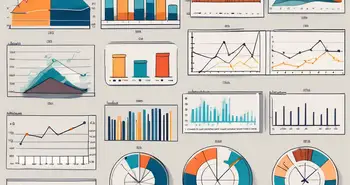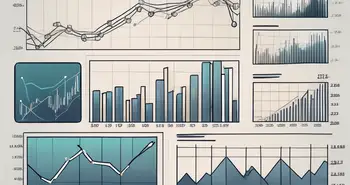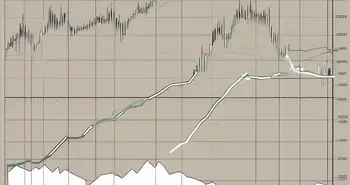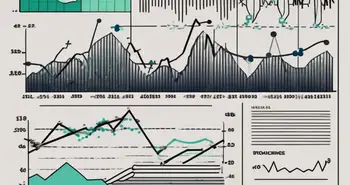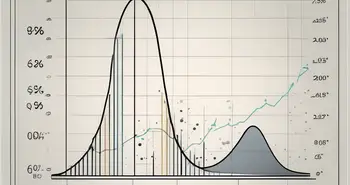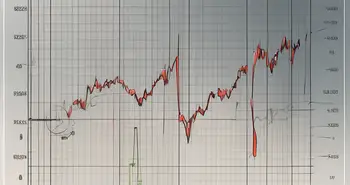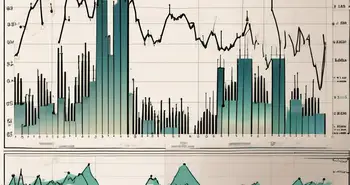Article Contents
An Introduction to the Rate of Change Indicator
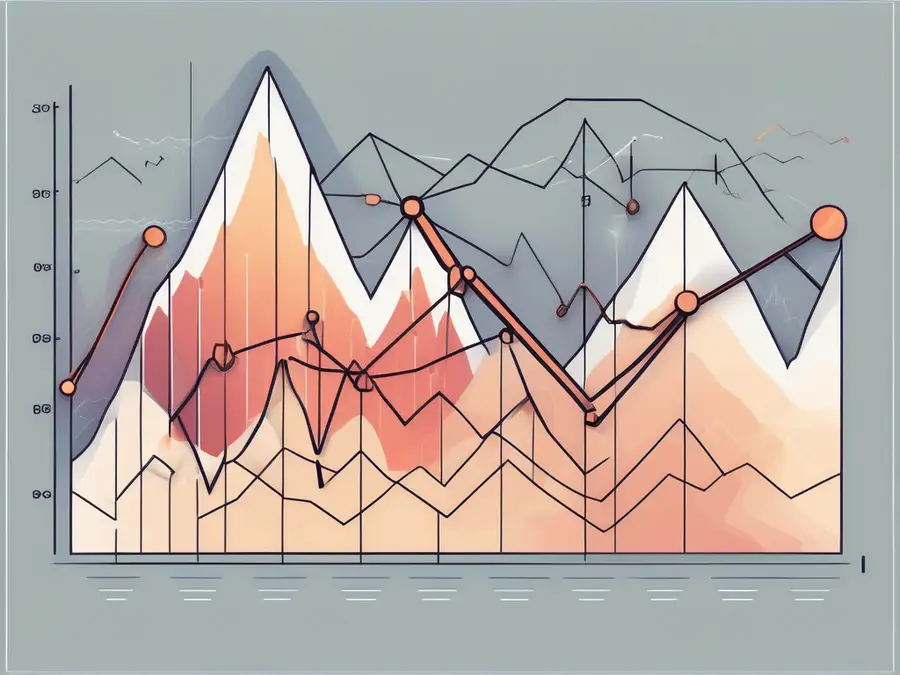
If you're looking to gain a competitive edge in the world of trading, then understanding and harnessing the power of indicators is essential. One such indicator that can provide valuable insights into market trends and potential trading opportunities is the Rate of Change Indicator. In this article, we will delve deep into the workings of this indicator and explore how it can be used to enhance your trading strategy.
Understanding the Rate of Change Indicator
Before we dive into the intricacies of the Rate of Change Indicator, let's first establish the basics. This indicator, also known as ROC, measures the percentage change in price over a specified time period. It reflects the velocity at which prices are changing, and by analyzing this change, traders can gain insights into market momentum.
The Rate of Change Indicator is a momentum oscillator that can help identify overbought or oversold conditions in a market, as well as potential trend reversals. By understanding the ROC's calculations and interpreting its signals, traders can make informed decisions and maximize their profit potential.
The Basics of the Rate of Change Indicator
Calculating the Rate of Change Indicator involves determining the percentage change in price over a given period. The formula for calculating ROC is as follows:
ROC = [(Closing Price – Closing Price n periods ago) / Closing Price n periods ago] * 100
This calculation measures the percentage change between the current closing price and the closing price n periods ago. The resulting value is then multiplied by 100 to express the change as a percentage.
For example, if the current closing price is $50 and the closing price 5 periods ago was $40, the Rate of Change Indicator would be ((50-40)/40)*100 = 25%. This indicates a 25% increase in price over the specified period.
Importance of the Rate of Change Indicator in Trading
Now that we understand how the Rate of Change Indicator is calculated, let's explore its significance in trading. By measuring the rate at which prices are changing, ROC can provide valuable insights into market momentum. Traders can use this information to identify potential trend reversals and make informed decisions regarding entry and exit points.
For example, if the ROC value is positive and increasing, it suggests that the market is experiencing upward momentum. Conversely, a negative and decreasing ROC value may indicate a downtrend. By monitoring these signals, traders can align their strategies with market trends and improve their chances of success.
Diving Deeper into the Rate of Change Indicator
Now that we have grasped the basics, let's dive deeper into the Rate of Change Indicator and explore additional aspects that can enhance your understanding.
How to Calculate the Rate of Change Indicator
We have already discussed the formula for calculating ROC, but it's worth reiterating its simplicity. By subtracting the closing price n periods ago from the current closing price and dividing it by the closing price n periods ago, we can obtain the percentage change. Multiplying this value by 100 then expresses it as a percentage.
It's important to note that the choice of the time period used in the calculation can significantly impact the indicator's results. Shorter time periods yield more sensitive and volatile signals, while longer time periods provide smoother and more gradual signals. Experimentation and testing are crucial to find the optimal time period for your trading strategy.
Interpreting the Rate of Change Indicator
Interpreting the Rate of Change Indicator requires a keen eye for spotting trends and understanding the relationship between price and momentum. Here are a few key points to consider:
- A positive ROC value suggests upward momentum, while a negative ROC value indicates downward momentum.
- Large positive or negative values may signify overbought or oversold conditions, respectively.
- Divergence between the ROC and price movement may indicate an upcoming trend reversal.
- Combining the Rate of Change Indicator with other technical tools can help confirm trading signals and increase their accuracy.
By honing your ability to interpret ROC signals, you can effectively gauge market sentiment and make informed trading decisions.
Strategies for Using the Rate of Change Indicator
Now that you have a solid understanding of the Rate of Change Indicator and its interpretation, let's explore some practical strategies for using this indicator to your advantage.
Timing Trades with the Rate of Change Indicator
Timing is crucial in trading, and the Rate of Change Indicator can help identify opportune entry and exit points. When the ROC crosses above the zero line, it may signal a buy opportunity, indicating upward momentum. Conversely, a crossing below the zero line may indicate a sell opportunity, suggesting a potential downtrend.
However, it's important to confirm these signals with other technical indicators or chart patterns to avoid false or premature trades. Combining the Rate of Change Indicator with tools such as moving averages or support and resistance levels can help increase the reliability of your trading signals.
Identifying Market Trends with the Rate of Change Indicator
Trends can provide significant profit opportunities, and the Rate of Change Indicator can assist in identifying them. By monitoring the ROC values over a longer time period, you can determine the overall trend's strength.
A rising ROC value above the zero line suggests a strong uptrend, whereas a falling ROC value below the zero line indicates a strong downtrend. By aligning your trades with the prevailing trend, you can increase your chances of success and reduce the risk of trading against the market's current direction.
Common Mistakes to Avoid with the Rate of Change Indicator
While the Rate of Change Indicator can be a powerful tool, it's vital to recognize and avoid common mistakes that can undermine its effectiveness.
Overreliance on the Rate of Change Indicator
While the Rate of Change Indicator can provide valuable insights, it should not serve as the sole basis for your trading decisions. It's crucial to consider other factors such as market fundamentals, news events, and overall market conditions. Combining the Rate of Change Indicator with other technical analysis tools can help confirm signals and reduce the likelihood of false positives.
Misinterpreting the Rate of Change Indicator Signals
Understanding the subtleties of interpreting ROC signals is critical to avoid costly trading mistakes. It's essential to consider the context of the market and take into account other technical analysis tools. Additionally, continually testing and optimizing your parameters can help fine-tune your strategy and improve accuracy.
Optimizing the Use of the Rate of Change Indicator
To further enhance your trading strategy, here are a few tips on optimizing the use of the Rate of Change Indicator:
Combining the Rate of Change Indicator with Other Tools
No single indicator can provide an all-encompassing view of the market. By combining the Rate of Change Indicator with other technical tools such as moving averages, volume analysis, or trend lines, you can gain a more comprehensive understanding of market dynamics. This combination can help filter out noise and increase the accuracy of your trading signals.
Fine-Tuning the Rate of Change Indicator Settings
As mentioned earlier, the choice of time period for calculating the ROC can significantly impact its results. It's crucial to experiment with different time periods and find the settings that align best with your trading style and objectives. By optimizing the indicator's parameters, you can fine-tune its sensitivity and maximize its effectiveness.
Remember, trading is both an art and a science. It requires continual learning, analysis, and adaptation. While the Rate of Change Indicator can be a valuable tool in your trading arsenal, it's important to integrate it into a comprehensive strategy that considers various factors and indicators.
As an expert in trading and technical analysis, I have extensively utilized the Rate of Change Indicator throughout my career. One piece of advice I would like to share is to always rely on multiple indicators and confirm signals to reduce the risk of false positives or premature trades. The Rate of Change Indicator, when used in conjunction with other tools, can provide valuable insights and enhance your decision-making process.
Frequently Asked Questions (FAQ)
What is the Rate of Change Indicator?
The Rate of Change Indicator, also known as ROC, measures the percentage change in price over a specified time period. It reflects the velocity at which prices are changing and can provide insights into market momentum.
How is the Rate of Change Indicator calculated?
The Rate of Change Indicator is calculated by subtracting the closing price n periods ago from the current closing price, dividing it by the closing price n periods ago, and then multiplying the result by 100 to express it as a percentage.
How can the Rate of Change Indicator be used in trading?
The Rate of Change Indicator can be used to identify potential trend reversals, overbought or oversold conditions, and market trends. By monitoring ROC signals and combining them with other technical analysis tools, traders can make informed trading decisions.
What are some common mistakes to avoid when using the Rate of Change Indicator?
Two common mistakes to avoid are overreliance on the Rate of Change Indicator and misinterpreting its signals. It's important to consider other factors, use other indicators, and continually test and optimize your parameters to improve accuracy.
How can the use of the Rate of Change Indicator be optimized?
To optimize the use of the Rate of Change Indicator, consider combining it with other technical analysis tools and fine-tune its settings. Experiment with different time periods and find the parameters that align with your trading style and objectives.
In conclusion, the Rate of Change Indicator can be a powerful tool in a trader's toolkit. By understanding its calculations, interpreting its signals, and integrating it into a comprehensive trading strategy, you can unlock its power and gain an edge in the ever-changing world of trading.
Ready to put the Rate of Change Indicator into action and elevate your trading game? Join Morpher, the revolutionary trading platform that's changing the game with zero fees, infinite liquidity, and the ability to trade a vast array of assets. Whether you're interested in stocks, cryptocurrencies, or even niche markets like NFTs, Morpher's blockchain-based platform offers unparalleled flexibility and control. Sign up now to experience the future of investing with a free sign-up bonus, and start trading with the power of blockchain on your side. Sign Up and Get Your Free Sign Up Bonus and begin your journey to smarter, more innovative trading today!

Disclaimer: All investments involve risk, and the past performance of a security, industry, sector, market, financial product, trading strategy, or individual’s trading does not guarantee future results or returns. Investors are fully responsible for any investment decisions they make. Such decisions should be based solely on an evaluation of their financial circumstances, investment objectives, risk tolerance, and liquidity needs. This post does not constitute investment advice.

Painless trading for everyone
Hundreds of markets all in one place - Apple, Bitcoin, Gold, Watches, NFTs, Sneakers and so much more.

Painless trading for everyone
Hundreds of markets all in one place - Apple, Bitcoin, Gold, Watches, NFTs, Sneakers and so much more.

